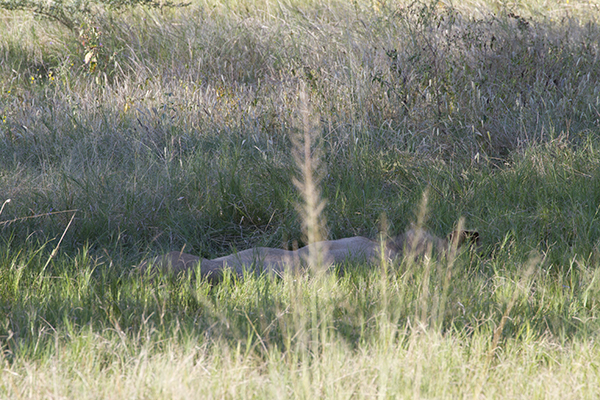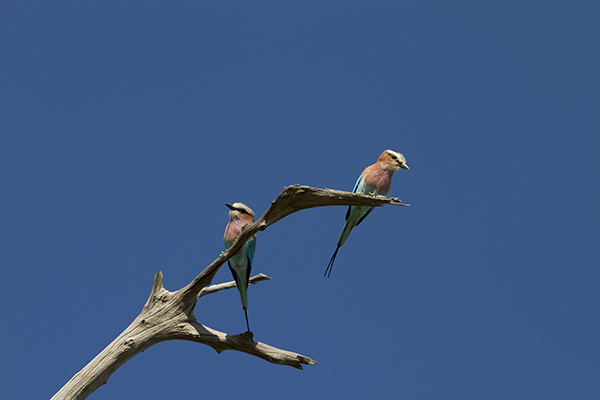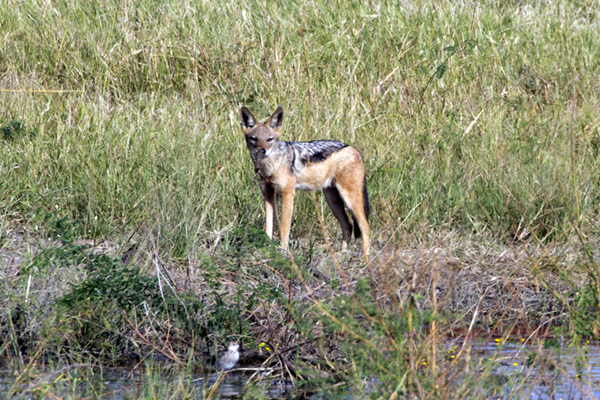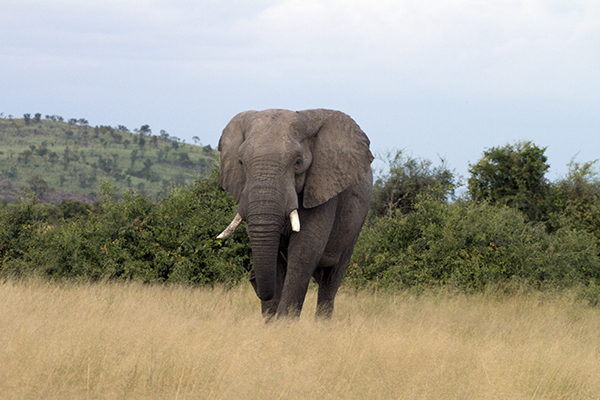We spent two nights in the Moremi Game Reserve, the largest reserve in the Okavango Delta. We were back in our tented camp and back to getting up at 5:30 for a very early start.
It is amazing that the sunrises here are just as spectacular as the sunsets! We are staying on the side of a large pond and it is totally calm this early in the morning.
We immediately spot a pair of cranes
and soon after that a spoonbill – he actually mischievous…
We watch him as he fishes for small organisms in a water hole
We were so busy looking at the spoonbill, admiring the way he fishes that we almost missed another animal quietly approaching. However, the spoonbill knew what was going on and he alerted us when he started looking around. There is a Hyena going home after a long night of hunting.
We were amazed that it kept approaching us, looking around, but not necessarily at us. It stopped for a drink
before going on around us – it is only at this stage that it looked at us, as if saying “Now where did you come from?”
A little further, there was a large harem of Impalas – and a young Impala was still nursing, even though he already had horns appearing – I hope he is careful not to hurt his mother with those…
Near the Third Bridge, and one of the old gates of the reserve, we came very close to elephants eating on the side f the road.
It is unusual to see this many vultures in a tree – it usually means that there has been a kill nearby, but we could not see anything.
A Hartebeast – we did not see many of these.
A large giraffe – we saw a lot more of those…
The Warthog does not have long legs – in my family, he would be called a “Zand Blaser” – but his neck is just as short so he has to kneel in order to graze on the ground. It makes for a very awkward position, and even more awkward way to move while grazing.
Here is the “Third Bridge” – I think this is really stretching the definition of ‘bridge’ if you ask me! There are signs every where that it is forbidden to swim near the bridge. A few years ago, a tourist was killed by a local crocodile while trying to freshen up – the tourist came from Australia …
Beautiful Egyptian Geese
On the way back to camp for our lunch break, we saw a black egret fishing. It makes a ring with its wings to create some shadow so it can look better through the water. Occasionally it sticks its head through the wings – very interesting to watch.
This is the view from my tent!
And here is a picture of my tent – you can see the shower in the back of it
In the afternoon, we ran into a Hammerkop (or Hammerhead – but that name was already taken!). A name well deserved. We had already seen the nests that they make – a really huge nest, so I was expecting a larger bird.
We saw a lazy lion – yes, there is a lion there, believe me. We stayed for a while to see if it moved, but without success
Finally a good Kudu face
We ran into a group of Vervet Monkeys. They are amazingly human in some of their attitudes…
There was also a small baby
After a couple of hours of driving around, we went back to our lazy lion – it had clearly made a huge effort and moved to a slightly different position, on the very same spot!
And we did get lucky – it looked up for about 15 seconds before going back to its state of rest…
This is Fourth Bridge – there is also First and Second Bridge, in case you are wondering … This one is a little more deserving of the appellation ‘Bridge’ as is actually goes over the water. With our Landcruizers, it is a tight fit and we had to cross this bridge several times a day. The wood would creak and groaning threateningly as the car slowly moved across.
The truck used to transport our camp is both too big and too heavy to take the bridge, so it has to go through the river
A good way for Bands to impress us with his driving skills
Back at camp after sunset. For a change, we do not face the sunset, so I was not able to get really spectacular photos on this first full day in the park.
The next day is going to be the longest day of the trip for all of us. We have to move from Moremi to Savute, about 200 km of dirt roads. It is quite a long day for us, but it is even longer for Bands and his team. They have to disassemble the camp AFTER we leave, drive the same 200 km and then re-assemble everything BEFORE we arrive at the new location. We will not have a break for lunch in the middle of the day, other than the pic-nic which we are carrying in the car.
We really have some spare time before we have to leave the Moremi Game Reserve, and so we start slowly, looking for animals we have not seen before. As soon as we leave, Stanley spots a Serval in the distance, a medium sized wild cat (slightly larger than a house cat).
We saw giraffes walking in front of a large group of impalas.
We have all seen giraffes drinking. Their neck is long, but so are their legs and therefore they have to straddle quite a bit to be able to reach the ground. It is amazing to see them get back up. They ‘throw’ their neck upwards and the momentum lifts their whole body so that they can close their legs … not something that is easy to show with pictures…
I take a lot of pictures. And sometimes I wonder why I take several times what might be the same identical picture. I took several pictures of giraffes drinking that day, most of them similar to the one above. But then, occasionally, just some times, one of the pictures turns out to be different. There is no way that you can plan this shot, and I can take no credit for it other than being in the right place at the right time and snapping the shot with the right adjustments of my camera!
This is my “Drunken Giraffe”!
We had not yet seen any significant numbers of Cape Buffaloes. We still did not, but had the occasional sight of a lone male. We did see a larger group, but they were inside bushes and impossible to get a good shot of.
We left the Moremi Game Reserve a little before 11 AM through the Khwai Gate, named after the river that flows just outside the fence – so this is the other Bridge over the River Khwai – they have a standard design for bridges, it would appear…
After the bridge, there was a sign indicating that we only had 112 km to go for Savute! Probably only 4 hours if we were to drive directly. The first 46 km to Mababe Gate should be quick as the road is better than in the Game Reserve and there should not be too many animals to look at …
Famous Last Words! We were starting to relax for about one hour of ‘fast’ driving, around 50 km/hr on a relatively smooth and straight road, when I felt Stanley apply full emergency breaks. I heard him saying something about an animal on the side of the road so I started to take my camera and get up for a better look. I took this picture of a ‘stunned’ leopard’ before the car had come to a complete stop…
He was just as stunned as we were and just stood there, not quite sure what to do. I had time to take another shot, even closer.
It recovered after a few seconds, regained is ‘cat-cool’ and with his dignity intact, and his tail high, slowly walked away into the bushes on the side of the road.
Once inside the Chobe National Park, we started seeing animals again. We had a really good look at this Secretary Bird – amazing legs! At the risk of being called ‘sexist’: is this where the name came from?
A Banded Mongoose standing watch
A majestic Kudu
Two young Impalas play-fighting
We saw a few Baobab trees, this one was much larger than the others. I am glad I had an opportunity to see it with a car in front in order to give the scale of the tree.
We started seeing more Zebras in this area.
A male Impala worried about his harem – I am not sure what would be a better life: to have a harem and constantly have to watch everything to make sure that you keep it, or not to have a harem and occasionally, have a fight with the dominant male to see if you can beat him.
Elephant!
And more giraffes – another set of bookends.
We are getting to the end of the day, and just as the sun starts to set, we get the word from Bands that the camp is ready. We are glad, but probably not as happy as the team that just moved our camp 200 km…
Savute is an area in the middle of the Chobe National Park, located in North-East Botswana. We are going to stay here three nights so we will have two full days to explore.
The moon is almost full and therefore sets a little after the sunrise. It is still visible above the zebras in this early morning shot.
African Zebra Crossing! I know, done it before, but it was worth repeating…
Two more Lilac Breasted Rollers with a dark blue sky in the background
We ran into several large groups of elephants, almost all of them with very young babies
“Small, Medium and Large” …
A Warthog. In this area, they had a lot more hair on their back and this looked rather brownish red, an interesting contrast to the dark grey skin.
Close up of an elephant drinking
Red Beak Hornbill
Close up of a giraffe’s head
We ran into a very large group of Zebras. They were looking at us as well.
So I created another panorama in order to show the full extent of the group (you will have to scroll right to see it all). We estimate that there must be close to 1000 zebras.
For the first time on this trip, the sky looks threatening, as if it might actually start to rain.
Elephants are eating in the setting sunlight
A Yellow Beak Hornbill contrasted against the darkening sky
The advantage of clouds at sunset is that it makes for more spectacular photos after the sun has set.
One more…
The next day, we saw another beautiful Fish Eagle, taking off while I was taking his picture.
A Saddle Billed Stork in a nearby pond
More Giraffes and Zebras – it is amazing how often you see these animals together…
Giraffes peaking over the tree-line
We ran into another Jackal, having a drink in a small pond where there was a large hippo.
Around that same pond, there were also Ostriches and Wildebeast.
However, the main attraction was in the middle of the pond. There was just one hippo (there was not much room for more) and he was not happy to see us. We were treated to a rare show of defiance ..
It lasted several minutes and alternated between gesticulation with open mouth and also splashing of the pond…
Fortunately, he only gestured to tell us that this was his pond, and we should not come into it; he had no intention of chasing us away, and we had no intentions of joining him where he was – so we ended up parting mutually satisfied.
Have you ever thought that an elephant’s trunk can be heavy to carry by the head all day long? What does an elephant do when he needs a rest? Check out how relaxed this elephant looks with his trunk non-chalantly draped over one of his tusks
More Warthogs with red fur
After lunch, we were given permission to visit our camp kitchen, an area normally off-limits to the guests. The cook is on the right talking with Sue. The two metal boxes on the lower right are the “ovens” in which she is able to bake fresh bread daily. Most of the meals are cooked on the open fire.
They are still doing the dishes from our lunch. You can see the refrigerator in the background. It must be lifted about 5 feet (more than 1.5 m) to get into the truck each time the camp moves and only human muscle is used to do that… There is also a gas cooker, but seldom used.
Our cook in the middle of her domain
Sue and her exchanged addresses and recipes
That afternoon, our last full day in Savute, we decided to take a closer look at the Baobad trees in the park. We first ran into this large tree recently brought down by elephants. They are still feeding on it even though they are difficult to see. There is one on the right of the picture hiding behind a small tree. There were two more on the other side of the tree.
The Baobabs we saw here are not as “ridiculous looking” as the ones I remember near Broome in Western Australia. In the Kimberlies there, the trees really have a huge trunk and then almost no foliage of any sort on top. Here the trees are, if anything, larger and much more furnished on top. It is difficult to get a real scale for something like this.
There was one area where several trees grew together – a sort of Baobab Forest; we stopped for a closer look and actually measured one of the trees. It took six of us finger tip to finger tip to complete a full circle at the base of the trunk.
Here is the tree that we measured – it is probably more than 400 years old.
Driving back to camp, we saw more elephants. We must have disturbed this one at a bad time as he started tooting at us, flapping his ears and threatening us with his trunk.
A little further, a larger group of elephants were taking their evening bath. Two younger animals were playing in the background.
While their older brothers were being more serious, at least it looked more serious when tons of mamals chase each other across the water …
then face each other pushing and shoving…
We decided to take a break and have our sunset drinks here.
While the fighting kept going on and kept us focused in one direction, a very large male decided to come towards us from the other side. This is where Stanley indicated to us that we should stay close to the vehicles so that the elephant cannot differentiate us – they are used to cars, but not individuals walking around and that might provoke them into an attack.
Our time in Savute is coming to an end. Tomorrow is the last great move. We, as well as the camp and all our material, are moving to the North-East corner of Botswana and of the Chobe National Park, right along the Chobe River and just South of the border with Namibia. The drive is not as long as the previous one and therefore should be more relaxed.
The last episode of Botswana will come soon…
(2832 Page Views)


























































































Awesome! I love the giraffe photos. They look so graceful despite their awkward size and I can’t believe you get fresh bread every morning! You’re spoilt!!